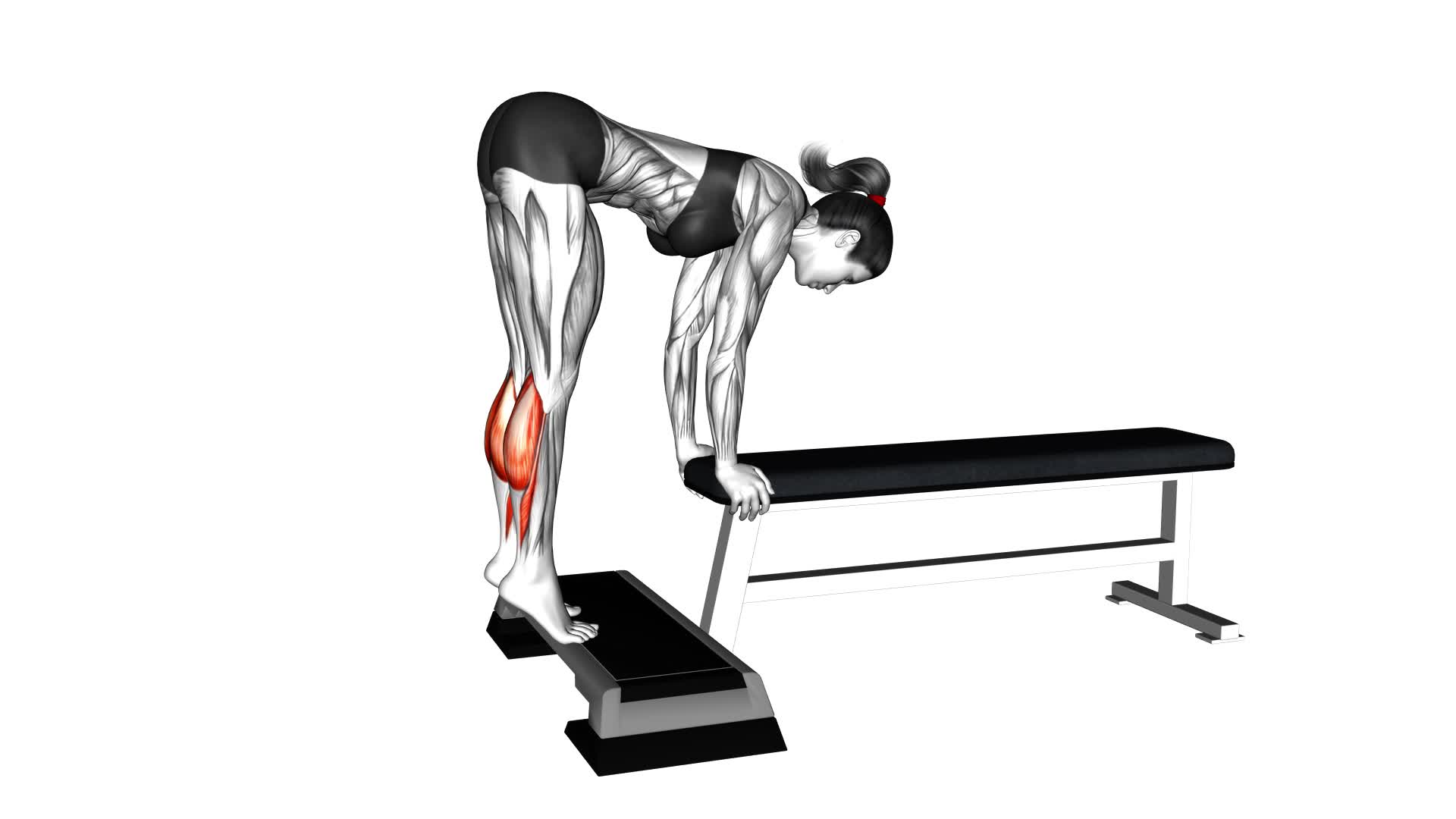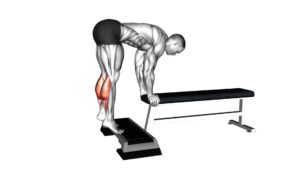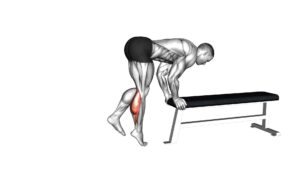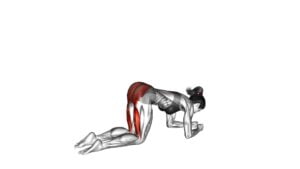Donkey Calf Raise (female) – Video Exercise Guide & Tips

In this video exercise guide, you'll learn all about the donkey calf raise, specifically designed for females. Discover the benefits of this targeted exercise, as well as proper form and technique to maximize your results.
Watch This Exercise Video
We'll also explore common mistakes to avoid and provide tips for increasing intensity. Whether you're a beginner or an experienced fitness enthusiast, this guide will help you master the donkey calf raise and take your lower body workout to the next level.
Let's get started!
Key Takeaways
- Donkey Calf Raise targets gastrocnemius and soleus muscles for improved lower leg aesthetics
- Regular performance of Donkey Calf Raise increases size and definition of calf muscles
- Donkey Calf Raise enhances athletic performance by strengthening calf muscles
- Proper form and technique of Donkey Calf Raise aids in injury prevention by providing stability and support to ankles
Benefits of Donkey Calf Raise
You can reap numerous benefits from incorporating donkey calf raises into your fitness routine. One of the primary benefits is the targeted strengthening of your calf muscles. Donkey calf raises specifically target the gastrocnemius and soleus muscles, which make up the bulk of your calves. By regularly performing this exercise, you can increase the size and definition of your calf muscles, resulting in improved lower leg aesthetics.
In addition to aesthetics, donkey calf raises also help improve your athletic performance. Strong calf muscles are essential for activities such as running, jumping, and agility movements. By strengthening your calves, you can enhance your speed, power, and overall athletic ability.
Furthermore, donkey calf raises can aid in injury prevention. Strong calf muscles provide stability and support to your ankles, reducing the risk of sprains and strains. By incorporating this exercise into your routine, you can strengthen the muscles and tendons surrounding your ankles, making them more resilient to injuries.
To ensure you reap these benefits safely, it's crucial to practice proper form and technique when performing donkey calf raises. By maintaining a neutral spine, engaging your core, and using controlled movements, you can reduce the risk of injury and maximize the effectiveness of the exercise.
Proper Form and Technique
To perform the donkey calf raise with proper form and technique, position yourself on the donkey calf raise machine. Place your toes on the edge of the platform, with your heels hanging off. Adjust the height of the platform so that your shoulders are directly beneath the shoulder pads. This will ensure proper alignment and prevent strain on your back.
One common misconception about the donkey calf raise is that it only targets the calves. However, this exercise also activates the muscles in your lower back, glutes, and hamstrings. By maintaining a neutral spine and engaging your core, you can maximize muscle activation throughout your entire lower body.
To begin the movement, lower your heels as far as possible, feeling a stretch in your calves. Then, rise up onto your toes, squeezing your calves at the top of the movement. It's important to control the motion and avoid using momentum. Aim for a slow and controlled pace to fully engage the target muscles.
Remember to breathe throughout the exercise, inhaling as you lower your heels and exhaling as you rise up onto your toes. Focus on maintaining proper form and technique to maximize the effectiveness of the donkey calf raise and prevent any potential injuries.
Common Mistakes to Avoid
A common mistake to avoid when performing the donkey calf raise is neglecting to maintain proper alignment and engage the target muscles. Proper technique is essential to maximize the benefits of this exercise and prevent injury.
One of the most common mistakes is allowing your heels to lift off the platform. To avoid this, make sure to keep your feet flat throughout the movement, maintaining contact with the platform at all times.
Another mistake is relying on momentum instead of using the muscles to lift the weight. Remember to move in a slow and controlled manner, focusing on the contraction of your calf muscles.
It's also important to avoid locking your knees at the top of the movement. Keep a slight bend in your knees to maintain tension on the calves.
Lastly, improper positioning of the weight can lead to ineffective results. Ensure that the weight is centered on your back, and not leaning too far forward or backward.
Tips for Increasing Intensity
To further challenge your calf muscles and increase the intensity of the donkey calf raise, focus on progressively adding more weight or resistance. Here are some tips for increasing the resistance and incorporating advanced techniques into your donkey calf raise workout:
- Use a weighted vest or hold dumbbells in your hands to increase the load on your calf muscles.
- Try using a resistance band around your shoulders and holding the ends with your hands for added resistance.
Experiment with different foot positions, such as toes pointed outward or inward, to target different areas of your calves.
Slow down the movement by lowering your heels slowly and then exploding upward, emphasizing the eccentric and concentric phases of the exercise.
Incorporate plyometric variations, such as explosive donkey calf raises or single-leg donkey calf raises, to further challenge your calf muscles.
By implementing these tips, you can push your calf muscles to new limits and continue making progress in your donkey calf raise routine.
Now let's move on to the next section where we'll discuss variations and modifications of the donkey calf raise exercise.
Variations and Modifications
If you're looking to switch up your donkey calf raise routine and add some variety to your calf workouts, there are several variations and modifications you can try.
One option is to perform the modified donkey calf raise, which involves using a step or elevated surface to elevate your heels while keeping your toes on the ground. This variation allows for a greater range of motion and can help target different areas of your calf muscles.
Another alternative to the donkey calf raise is the standing calf raise. This exercise is performed while standing and involves raising your heels as high as possible by pushing off with the balls of your feet. The standing calf raise can be done with both legs together or one leg at a time to increase the intensity.
Additionally, you can incorporate the seated calf raise into your routine. This exercise is performed using a seated calf raise machine or a weight plate placed on your thighs, and it targets the soleus muscle in the lower part of your calf.
Frequently Asked Questions
What Other Exercises Can I Incorporate With the Donkey Calf Raise to Target the Same Muscle Group?
To target the same muscle group as the donkey calf raise, you can incorporate other exercises into your routine. These exercises can help you further strengthen and develop your calf muscles.
Some options include standing calf raises, seated calf raises, and calf press on the leg press machine. By incorporating these exercises, you can ensure that you're effectively targeting and working the muscles in your calves.
How Many Sets and Reps Should I Do for the Donkey Calf Raise to See Results?
To see results with the donkey calf raise, you should aim to do 3 to 4 sets of 10 to 15 reps. This will help target the calf muscles effectively and promote growth and strength.
Remember to maintain proper form throughout the exercise and avoid common mistakes like using momentum or lifting too heavy of a weight.
To mix it up, you can also try alternative variations like seated calf raises or standing calf raises.
Can I Perform the Donkey Calf Raise Without a Partner or Specialized Equipment?
Yes, you can perform the donkey calf raise without a partner or specialized equipment. There are alternative exercises you can do to target your calf muscles.
However, the donkey calf raise offers unique benefits such as increased range of motion and targeted muscle engagement. It's recommended to incorporate this exercise into your routine if you have access to the necessary equipment or a partner to assist you.
Are There Any Specific Warm-Up Exercises or Stretches I Should Do Before Attempting the Donkey Calf Raise?
Before attempting the donkey calf raise, it's important to warm up and stretch properly. Start with some specific warm-up exercises that target your lower legs and calves, such as ankle rotations and toe touches. These exercises will help increase blood flow and flexibility in the muscles you'll be working during the donkey calf raise.
Additionally, perform calf stretches to further prepare your muscles for the exercise. Remember, warming up is crucial to prevent injuries and maximize the effectiveness of the donkey calf raise.
Can the Donkey Calf Raise Help Improve My Balance and Stability?
Improving your balance and stability is essential for overall fitness. The donkey calf raise can be a beneficial exercise to help you achieve this. By targeting the muscles in your calves, it can strengthen your lower body and improve your ability to maintain balance.
Additionally, this exercise also engages your core muscles, further enhancing your stability.
Incorporating the donkey calf raise into your workout routine can contribute to enhancing your balance and stability.
Conclusion
The donkey calf raise is an effective exercise for strengthening and toning the calves. By following proper form and technique, avoiding common mistakes, and incorporating tips for increasing intensity, you can maximize the benefits of this exercise.
Additionally, variations and modifications can be made to tailor the exercise to your fitness level and goals. Incorporating the donkey calf raise into your workout routine can help improve calf strength and enhance athletic performance.

Author
Years ago, the spark of my life’s passion ignited in my mind the moment I stepped into the local gym for the first time. The inaugural bead of perspiration, the initial endeavor, the very first surge of endorphins, and a sense of pride that washed over me post-workout marked the beginning of my deep-seated interest in strength sports, fitness, and sports nutrition. This very curiosity blossomed rapidly into a profound fascination, propelling me to earn a Master’s degree in Physical Education from the Academy of Physical Education in Krakow, followed by a Sports Manager diploma from the Jagiellonian University. My journey of growth led me to gain more specialized qualifications, such as being a certified personal trainer with a focus on sports dietetics, a lifeguard, and an instructor for wellness and corrective gymnastics. Theoretical knowledge paired seamlessly with practical experience, reinforcing my belief that the transformation of individuals under my guidance was also a reflection of my personal growth. This belief holds true even today. Each day, I strive to push the boundaries and explore new realms. These realms gently elevate me to greater heights. The unique combination of passion for my field and the continuous quest for growth fuels my drive to break new ground.



